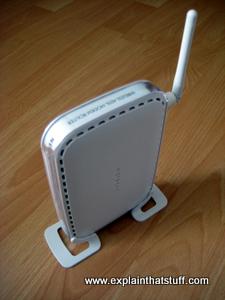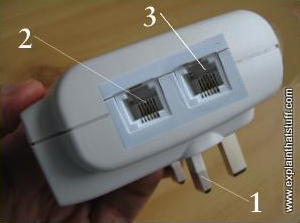
Broadband over power lines (BPL)
by Chris Woodford. Last updated: February 13, 2022.
High-speed Internet access anywhere, anytime—that's what we've increasingly come to expect in the 21st-century information age. But what if you live in a rural area where it's too expensive for a telecoms company to provide broadband? Or what if your house has old telephone wiring or the room you want to work in doesn't have a telephone access point? Worry not! The solution could be BPL (broadband over power lines), also called EOP (Ethernet over power)—a way of piping broadband to your home and channeling it from one room to another using the standard electricity supply. BPL is also known as HomePlug (the name of an alliance of manufacturers who make the equipment) and, in the UK, as "networking over the mains." Let's take a closer look at how it works!
Photo: Powerlines like this run almost everywhere, so why not use them to carry broadband Internet as well as electricity? Photo by Ryan Quijas courtesy of US Space Force and DVIDS.
Sponsored links
Contents
Sending two signals down one line
If you know something about broadband Internet already, you're probably aware that it works by splitting your ordinary telephone line into a number of separate channels. Some of them carry your phone calls, as usual, some carry downloads (information coming from the Internet to your home), and some handle uploads (information going the opposite way). Broadband uses low-frequency electric signals (the equivalent of low-pitched sounds) to carry ordinary phone calls and higher-frequency signals (like high-pitched sounds) to carry Internet data. Electronic filters separate the two kinds of signal, with the low frequencies going to your telephone and the higher frequencies to your Internet modem.
Does that sound so strange? It's really not so hard to use a single medium to carry more than one thing. People work this way all the time. If you've ever stood quietly in a corner of a cocktail party tuning in on different conversations, you'll know how easy it is to do. The air in the room is like a giant pipe carrying many different sounds to your ears. But, using something called selective attention, your brain can tune into one conversation or another depending on whom you find most interesting. Broadband Internet works a bit like this too. A single piece of telephone cable carries both phone calls and Internet data. Your telephone listens just to the calls; your modem lists only to the data.
Access BPL: bringing broadband to your home

Photo: With BPL, your modem takes its signal from your domestic electricity socket rather than your telephone socket.
If you can send computer data down a phone line, there's no reason why you can't channel it down a power line as well. Some Internet service providers (ISPs) are already using overhead and underground power lines to carry broadband data long distances to and from their customers in what's called access BPL. It's exactly the same principle as sending broadband over a phone line: a high-frequency signal carrying the broadband data is superimposed on the lower-frequency, alternating current that carries your ordinary electric power. In your home, you need to have slightly modified power outlets with an extra computer socket. Plug in a special BPL modem, plug that into your computer, and your broadband is up and running in no time.

Photo: The basic concept of powerline broadband: electric power lines can be used to bring broadband Internet to your home (or carry it from one room to another). That's because you can do more than one thing with the same electricity cable at the same time. Note that this is just an illustration: real-world BPL uses low- and medium-voltage lines, not the very high voltage lines that dangle between pylons.
In-house BPL: carrying broadband within your home
You can also use BPL with traditional telephone or cable broadband to bring Internet access to all the different rooms in your home. You simply plug the Ethernet lead from your normal modem into a special adapter that fits into one of the power outlets. Your home electricity circuit then takes the broadband to and from every room in your house as a high-frequency signal superimposed on top of the power supply. If you want to use broadband in a bedroom, you simply plug another Ethernet adapter into one of the ordinary power outlets in that room and plug your computer into it. In-house BPL, as this system is known, is a great way of getting broadband in any part of your home. It's particularly useful if you have a big house with thick walls that make wireless Internet impossible.
Hybrid approaches
Another approach to BPL is to use powerline infrastructure—either above or below ground—as a kind of physical backbone for entirely separate fiber-optic cables, so the Internet cables simply run alongside existing power cables without actually sending signals through them. This saves the considerable expense of acquiring land and digging trenches for fiber, and also avoids the technical challenges of trying to combine two separate signals in a single cable. It's similar to the idea of running cables alongside railroad tracks, down the middle of highways, and so on, but doesn't really have anything else in common with what we think of as BPL.
Smart homes of the future?
BPL opens up an even more exciting possibility for the future. If we can connect computers using the ordinary power lines in our home, there's nothing to stop us connecting up domestic appliances both to one another and to the Internet. Smart homes (in which appliances are switched on and off automatically by electronic controllers or computers) have used this basic idea for years—but BPL could take it much further and make it far more widespread. Imagine a future where you can use a Web browser on your computer at work to switch on the electric cooker in the kitchen at home, ready for when you arrive. Or how about using the Web browser on your cellphone to turn your home lights on and off when you're staying in a hotel, to give added protection against intruders? Just imagine the possibilities: BPL could take remote control to an amazing new level!

